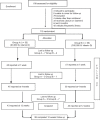Efficacy and Safety of 90,000 IU versus 300,000 IU Single Dose Oral Vitamin D in Nutritional Rickets: A Randomized Controlled Trial
- PMID: 30766814
- PMCID: PMC6330863
- DOI: 10.4103/ijem.IJEM_84_18
Efficacy and Safety of 90,000 IU versus 300,000 IU Single Dose Oral Vitamin D in Nutritional Rickets: A Randomized Controlled Trial
Abstract
Aim: To compare efficacy and safety of 90,000 IU versus 300,000 IU oral single dose vitamin D for treatment of nutritional rickets.
Study design: Randomized controlled trial.
Setting: Tertiary care hospital.
Participants: One hundred ten children (6 months to 5 years, median age 10.5 months) with rickets. Exclusion criteria were disease affecting absorption, intake of calcium/vitamin D preparation in last 6 months, abnormal renal function, and rickets other than nutritional.
Intervention: Vitamin D3 as a single oral dose 90,000 IU (group A, n = 55) or 300,000 IU (group B, n = 55).
Methodology: Severity of rickets was scored on knee and wrist X-ray as per Thacher's radiographic score. Baseline serum levels of calcium, SAP, 25(OH)D, iPTH were measured. Follow up was done at 1 week, 4 weeks, and 12 weeks.
Outcome variable: Primary - Radiographic score at 3 months. Secondary - Serum levels of 25(OH)D, SAP, and iPTH at 3 months, clinical and biochemical adverse effects.
Results: Eighty-six subjects (43 in each group) completed the study. The radiographic score reduced from 6.90 to 0.16 in group A and from 6.93 to 0.23 in group B. The levels of 25(OH)D, ALP, and PTH were similar between the groups at baseline and follow up. Hypercalciuria and hypercalcemia were seen more often in group B as was hypervitaminosis D. There were no clinical adverse events.
Conclusions: Single oral dose vitamin D3 90,000 IU is safe and effective in achieving healing of rickets.
Keywords: Nutritional rickets; radiographic score; vitamin D.
Conflict of interest statement
There are no conflicts of interest.
Figures
References
-
- Munns CF, Shaw N, Kiely M, Specker BL, Thacher TD, Ozono K, et al. Global consensus recommendations on prevention and management of nutritional rickets. Horm Res Paediatr. 2016;85:83–106. - PubMed
-
- Joshi K, Bhatia V. Vitamin D deficiency in a tropical country – Treatment and prevention in children. Indian J Pediatr. 2014;81:84–9. - PubMed
-
- Gupta P, Shah D, Ghai OP. Micronutrients in health and disease. In: Ghai OP, Gupta P, Paul VK, editors. Essential Pediatrics. 6th ed. New Delhi: CBS; 2004. p. 129.
-
- Shah BR, Finberg L. Single-day therapy for nutritional Vitamin D-deficiency rickets: A preferred method. J Pediatr. 1994;125:487–90. - PubMed
-
- Balasubramanian S, Dhanalakshmi K, Amperayani S. Vitamin D deficiency in childhood-a review of current guidelines on diagnosis and management. Indian Pediatr. 2013;50:669–75. - PubMed
LinkOut - more resources
Full Text Sources
Miscellaneous



